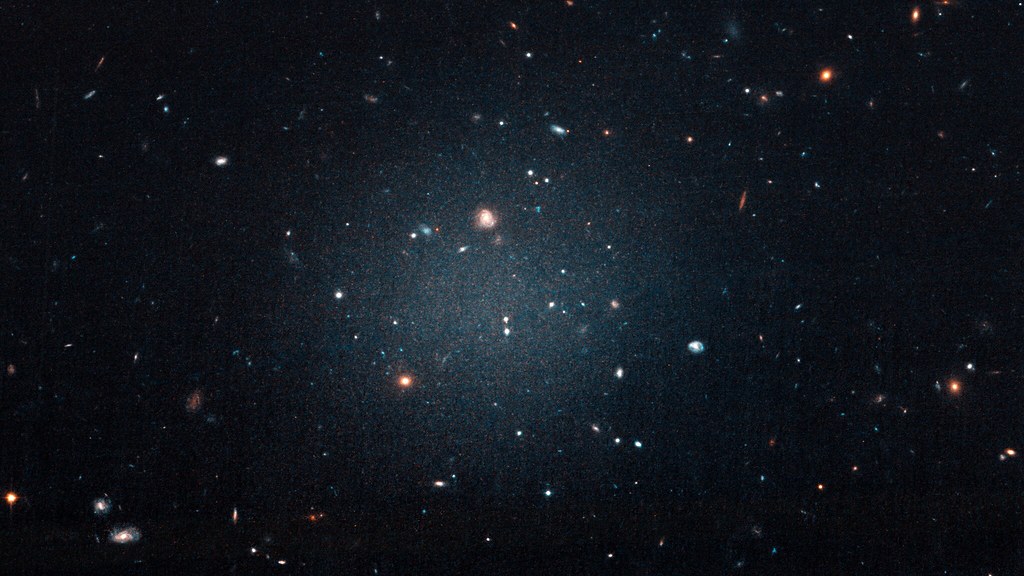
Scientists have detected the distribution of the oldest dark matter ever observed in the universe based on calculations from the glow of surrounding galaxies of twelve billion years ago.
The history of our entire universe is smeared across the vastness of space almost like photos dropped from a moving car. In other words, to see a succession of milestone moments of the development of space, all we need to do is keep looking further down the highway.
Unfortunately, the further away we look, however, the dimmer that starlight gets, making it harder to see the subtle influence of this most mysterious of forces.
The escalating expansion hasn’t been kind to those older snapshots, stretching their palettes of starlight until they’re so sapped of energy, they appear to us as little more than glowing embers.
A collaboration between Japan and US astronomers has found a different way to shine a light on the distant darkness, by studying the way shadowy masses of dark matter distort the background glow of the cosmos.
If those early galaxies look anything like the ones we see much later in the universe’s timeline, their structures should be influenced by pockets of gravity. Still, it is apparently embarrassing that we can’t identify them exactly.
‘Dark matter’ detected provides fewer properties for its nature
The recent distribution glimpsed is identified as ‘dark matter’ only because it doesn’t radiate any information that tells us something about its nature.
It is probably some kind of particle-like mass with few properties, not unlike a neutrino, but there’s an outside chance it’s a reflection of something we’ve misunderstood about the shaping of space and time.
Until now, scientists don’t have a concrete theory on where this phenomenon fits with existing physics, so getting a precise understanding of what those super-ancient dark matter halos looked like would at least tell us if they’ve changed over time.
It is impossible to estimate their total mass both invisible and glowing by simply measuring their pale light. It is possible, however, to rely on the way their collective mass distorts starlight passing through their surrounding space.
For large groups of galaxies seen some eight to ten billion years in the past, this lensing technique works well enough, but the further back we want to look, the less stellar radiation there is in the background to analyze for distortions.
Other sources considered in observing light in the universe
According to Nagoya University astrophysicist Hironao Miyatake and colleagues, the cosmic microwave background (CMB) is another source that can be used to observe light in the universe.
Scientists use subtle patterns in this background hum to test all kinds of hypotheses on the first critical phases in the universe’s evolution to estimate the average mass of distant galaxies and the distribution of dark-matter halos surrounding them.
An astrophysicist from the University of Tokyo, Masami Ouchi said, “It was a crazy idea. No one realized we could do this, but after I gave a talk about a large distant galaxy sample, Hironao came to me and said it may be possible to look at dark matter around these galaxies with the CMB.”
Focusing on a special set of distant star-forming objects called Lyman-break galaxies, Hironao and his colleagues went about analyzing patterns in the microwave radiation as seen by the European Space Agency’s Planck satellite.
This was done using a sample consisting of nearly 1.5 million of these objects collected through the Hyper Suprime-Cam Subaru Strategic Program survey.
According to standard cosmological theory, the formation of those early galaxies was largely determined by fluctuations in space exaggerating the clumping of matter.
The new findings of early galactic masses point to an interesting clumping of matter that is lower than currently favored models have predicted.
Miyatake noted that “our finding is still uncertain, but if it is true, it would suggest that the entire model is flawed as you go further back in time.”
Existing models on how freshly-baked elements came together to form the first galaxies could reveal gaps that may also explain the origins of dark matter, but, given the faded nature of the universe’s initial photos, the genesis of their presence leaves a lot to ponder.
See all the latest news from Greece and the world at Greekreporter.com. Contact our newsroom to report an update or send your story, photos and videos. Follow GR on Google News and subscribe here to our daily email!



